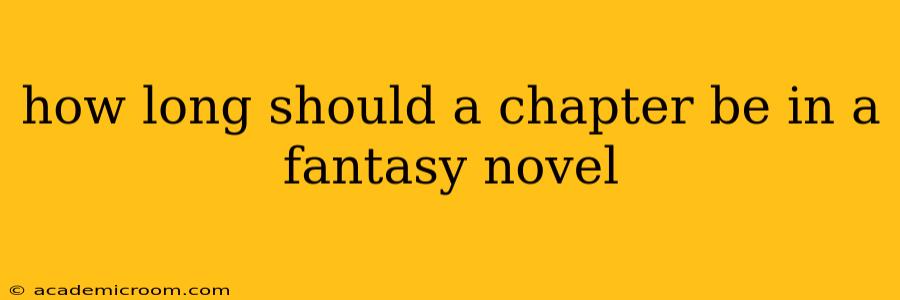How Long Should a Chapter Be in a Fantasy Novel?
The ideal chapter length in a fantasy novel is a surprisingly nuanced question, with no single "right" answer. It depends heavily on your writing style, the pacing of your story, and your individual reader's preferences. However, some guiding principles and common practices can help you determine what works best for your specific fantasy world.
There's No Magic Number: Unlike some genres, fantasy doesn't have a rigidly enforced chapter length. You won't find a publisher rejecting a manuscript solely because chapters average 8,000 words versus 5,000. What truly matters is the narrative rhythm and how effectively your chapter breaks support the overall reading experience.
Factors Influencing Chapter Length:
-
Pacing and Plot: Fast-paced action sequences might warrant shorter chapters to maintain momentum and keep the reader hooked. Conversely, slower, more introspective scenes or world-building sections could benefit from longer chapters to fully explore the nuances of the scene or character development.
-
Scene Breaks: A chapter should generally encompass a single scene or a related set of scenes that build towards a natural conclusion. Ending a chapter at a cliffhanger, a pivotal decision, or a significant plot development keeps the reader engaged and eager to continue. Conversely, abruptly ending a chapter mid-scene can be jarring.
-
Reader Fatigue: Extremely long chapters can tire the reader, making the book feel like a slog. Conversely, excessively short chapters can create a choppy, disjointed reading experience. Aim for a balance that keeps the reader engaged without overwhelming them.
-
Your Writing Style: Some authors naturally write longer, more detailed chapters, while others prefer a quicker, more fragmented approach. Trust your instincts and find a chapter length that feels natural and comfortable for your writing process.
What About Word Count? Common Ranges:
While there's no strict word count rule, common ranges are generally accepted as good starting points:
-
Shorter Chapters (500-1500 words): This works well for fast-paced scenes, action sequences, or stories with multiple viewpoints. Shorter chapters offer frequent breaks and can maintain reader interest.
-
Medium Chapters (1500-3000 words): This is a versatile range suitable for a variety of scenes, allowing for both action and character development. This length is often seen as a sweet spot for many fantasy novels.
-
Longer Chapters (3000+ words): These are typically reserved for pivotal scenes, major plot developments, or extended world-building sequences. They can be effective but should be used judiciously to avoid reader fatigue.
H2: What if my chapters are too long or too short?
If your chapters are consistently too long:
- Break them down: Identify natural breaks within the scene, such as shifts in location, time, or point of view. Each of these can serve as a logical point to start a new chapter.
- Focus on pacing: Ensure your scenes have a clear beginning, middle, and end. If a scene feels drawn-out, consider trimming unnecessary details or descriptions.
If your chapters are consistently too short:
- Combine related scenes: Look for opportunities to merge shorter chapters that naturally flow together.
- Expand on details: Consider adding more descriptive passages, character interactions, or internal monologues to give your scenes more depth and substance.
- Examine your pacing: Are you moving too quickly through the plot? Slowing the pace might allow for longer, more satisfying chapters.
H2: Do publishers have preferences regarding chapter length?
Publishers generally focus more on the overall quality of the manuscript rather than adhering to strict chapter length rules. While there might be an internal preference, a manuscript with well-paced, engaging chapters of varying lengths is preferable to one with poorly structured chapters of uniform length, regardless of word count.
Ultimately, the "best" chapter length is subjective and depends entirely on your narrative choices. Experiment, find your rhythm, and most importantly, focus on crafting compelling storytelling that will resonate with your readers.
